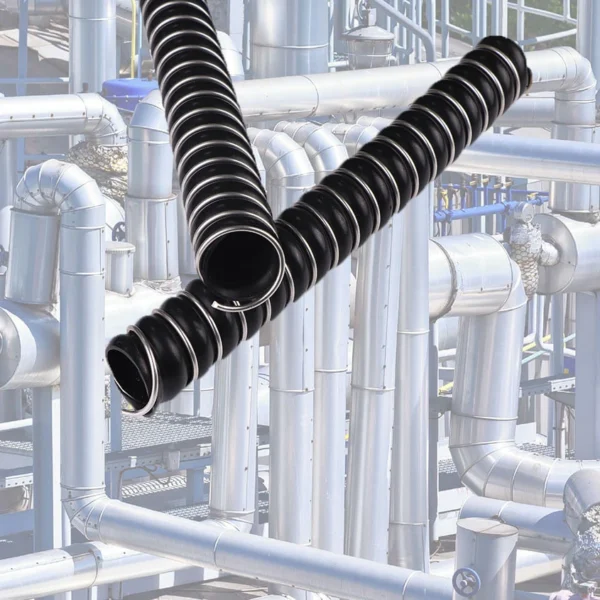Introduction
→ “What makes conductive PTFE hoses different from regular PTFE hoses? Which one suits your industrial needs? This comprehensive guide compares their properties, applications, and performance data to help you make informed decisions.”
PTFE Hose Basics: Material Properties and Manufacturing
What is PTFE?
Polytetrafluoroethylene (PTFE) is a synthetic fluoropolymer known for its exceptional chemical resistance, non-stick properties, and thermal stability (-70°C to 260°C). Both conductive PTFE hoses and regular PTFE hoses share these core attributes but differ in electrical conductivity.
Key Manufacturing Differences
- Conductive PTFE Hose: Infused with carbon or metal particles (e.g., stainless steel) to reduce surface resistivity to ≤10⁴ ohm/sq, meeting anti-static standards like ATEX/IEC 60079.
- Regular PTFE Hose: Pure PTFE with inherent insulation properties (resistivity ≥10¹⁴ ohm/sq).
Conductive PTFE Hose: Advantages and Critical Applications
Why Choose Conductive PTFE?
- Static Dissipation: Prevents spark risks in flammable environments (e.g., ptfe fuel hose in petroleum transfer)[^1].
- Durability in Harsh Conditions: Resists abrasion, UV exposure, and aggressive chemicals like hydrocarbons.
- Compliance: Meets OSHA and IEC safety standards for explosive atmospheres.
Common Use Cases
- Oil and Gas: Transferring fuels, solvents, and oil hose systems.
- Pharmaceuticals: Safe handling of ethanol and acetone.
- Aerospace: Hydraulic fluid lines requiring static control.
Regular PTFE Hose: Ideal Scenarios and Limitations
Strengths of Non-Conductive PTFE
- Ultra-Pure Fluid Transfer: No risk of contamination in food-grade or semiconductor applications.
- Electrical Insulation: Ideal for high-voltage equipment.
- Cost Efficiency: 15–20% cheaper than conductive variants[^2].
Typical Applications
- Chemical Processing: Handling acids (e.g., sulfuric, nitric) where conductivity isn’t required.
- Food and Beverage: Sanitary transfer of oils (oil resistant hose) and syrups.
Head-to-Head Comparison: Conductive vs. Regular PTFE Hoses
| Property | Conductive PTFE Hose | Regular PTFE Hose |
|---|---|---|
| Surface Resistivity | ≤10⁴ ohm/sq | ≥10¹⁴ ohm/sq |
| Best For | Flammable media, static-prone areas | Non-conductive environments |
| Chemical Resistance | Excellent (comparable) | Excellent |
| Cost (per meter) | $50–$80[^3] | $40–$65 |
| Compliance | ATEX, IEC 60079 | FDA, USDA |
How to Choose: 5 Factors to Consider
- Electrical Requirements: Opt for ptfe conductive hoses if static discharge is a hazard.
- Chemical Compatibility: Both types resist oils (oil resistant hose), fuels, and acids.
- Temperature Range: PTFE performs consistently from -70°C to 260°C.
- Regulatory Needs: Conductive hoses for explosive zones; regular for food-grade use.
- Budget: Balance safety needs with cost constraints.
FAQs: Addressing Common Queries
Can a regular PTFE hose be used for fuel transfer?
→ Not recommended due to static risks; use a ptfe fuel hose with conductivity.
Do conductive hoses require special maintenance?
→ No—clean with standard solvents like acetone.
Which hose lasts longer?
→ Both offer 10–15 years lifespan under proper conditions[^4].
Conclusion and Next Steps
→ Immediate Action: Audit your application’s static risks and chemical exposure. For fuel, chemical, or explosive environments, prioritize conductive PTFE hoses. For food, pharmaceuticals, or insulated systems, regular PTFE is optimal. Always verify manufacturer certifications (ISO 9001, ASTM D876) before purchasing.
[^1]: OSHA Standard 1910.106 – Flammable Liquids
[^2]: 2024 Global PTFE Market Report, Grand View Research
[^3]: Parker Hannifin Industrial Hose Pricing Guide
[^4]: DuPont™ PTFE Lifespan Testing Data
Black PTFE Corrugated Pipe – Flexible Hose for Automotive
Black PTFE corrugated pipe, made from Teflon X, deliver top-tier softness and fluid discharge for automotive and medical uses. These flexible corrugated hoses reduce friction and valley depth for efficient cleaning and performance. Spiral steel reinforcement ensures kink resistance, making this teflon hose ideal for high-temperature settings.



